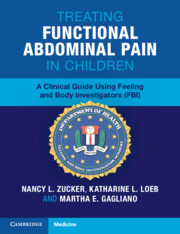 Treating Functional Abdominal Pain in Children
Treating Functional Abdominal Pain in Children Book contents
- Treating Functional Abdominal Pain in Children
- Treating Functional Abdominal Pain in Children
- Copyright page
- Dedication
- Contents
- Acknowledgements
- Part I The Background Science Behind Feeling and Body Investigators
- Part II A Session-by-Session Guide to Feeling and Body Investigators
- Chapter 6 Session 1: Initiation into Feeling and Body Investigators
- Chapter 7 Session 2: The Eats
- Chapter 8 Session 3: The Explosions
- Chapter 9 Session 4: The Zoomies and the Shakies, Part 1
- Chapter 10 Session 5: The Blahs
- Chapter 11 Session 6: The Ouchies
- Chapter 12 Session 7: The Drowsies
- Chapter 13 Session 8: The Zoomies and the Shakies, Part 2
- Chapter 14 Session 9: The Soothies
- Chapter 15 Session 10: The Celebration… and the Next Leg of Our Journey
- Part III Sample Workbook Pages, Handouts, and Additional Resources for Feeling and Body Investigators
- Index
- References
Chapter 14 - Session 9: The Soothies
from Part II - A Session-by-Session Guide to Feeling and Body Investigators
Published online by Cambridge University Press: 18 November 2023
- Treating Functional Abdominal Pain in Children
- Treating Functional Abdominal Pain in Children
- Copyright page
- Dedication
- Contents
- Acknowledgements
- Part I The Background Science Behind Feeling and Body Investigators
- Part II A Session-by-Session Guide to Feeling and Body Investigators
- Chapter 6 Session 1: Initiation into Feeling and Body Investigators
- Chapter 7 Session 2: The Eats
- Chapter 8 Session 3: The Explosions
- Chapter 9 Session 4: The Zoomies and the Shakies, Part 1
- Chapter 10 Session 5: The Blahs
- Chapter 11 Session 6: The Ouchies
- Chapter 12 Session 7: The Drowsies
- Chapter 13 Session 8: The Zoomies and the Shakies, Part 2
- Chapter 14 Session 9: The Soothies
- Chapter 15 Session 10: The Celebration… and the Next Leg of Our Journey
- Part III Sample Workbook Pages, Handouts, and Additional Resources for Feeling and Body Investigators
- Index
- References
Summary
In our last session of new material, we focus on body sensations that are soothing and pleasant. Practicing ways to lower our heart rate has been a part of every session and thus, by the time Session 9 occurs, children are very good at noticing and embracing calm, soothing sensations, This session is about rejoicing in moments of slow-moving wonderment – drifting off into a daydream, feeling the warmth of a smile, feeling alert as your senses take in everything around you. Children practice noticing everything surrounding them when they just stop and take in the moment. They see where their mind travels to when they find a restful spot to day dream. They feel time slipping away as they become engrossed in something that really focuses their attention. Catching and holding onto soothing moments is a wonderful way to live.
Keywords
- Type
- Chapter
- Information
- Treating Functional Abdominal Pain in ChildrenA Clinical Guide Using Feeling and Body Investigators (FBI), pp. 123 - 128Publisher: Cambridge University PressPrint publication year: 2023
